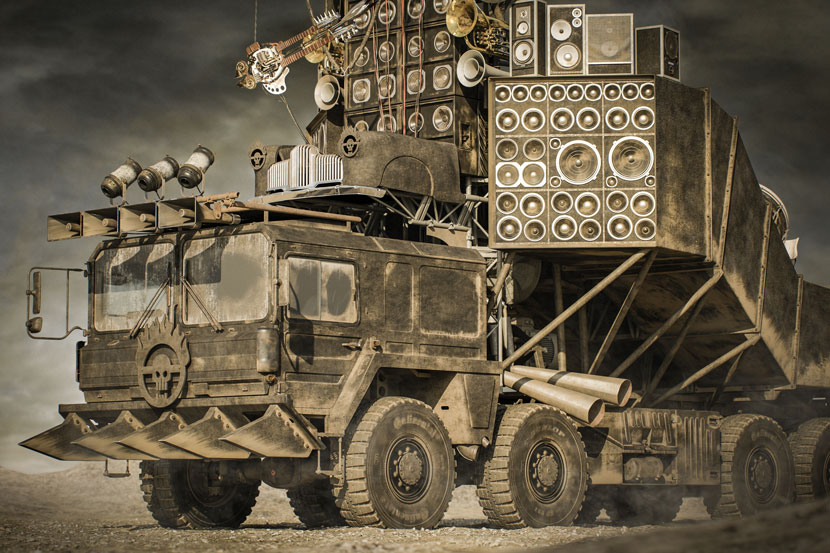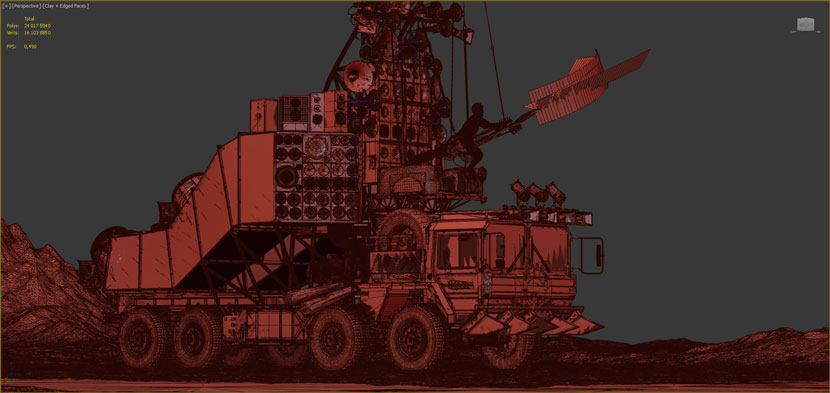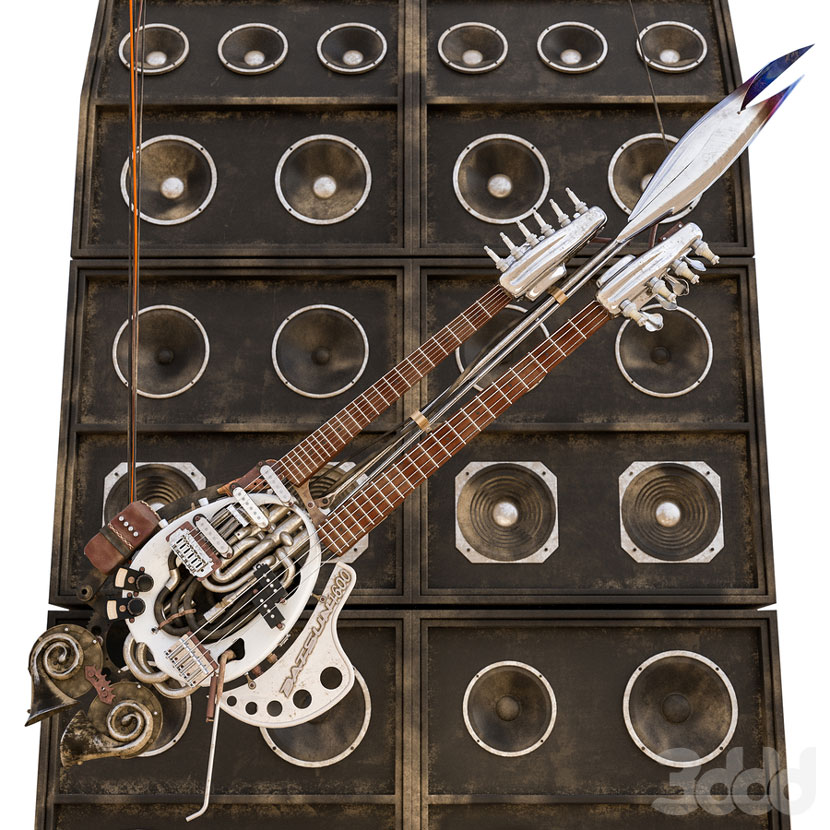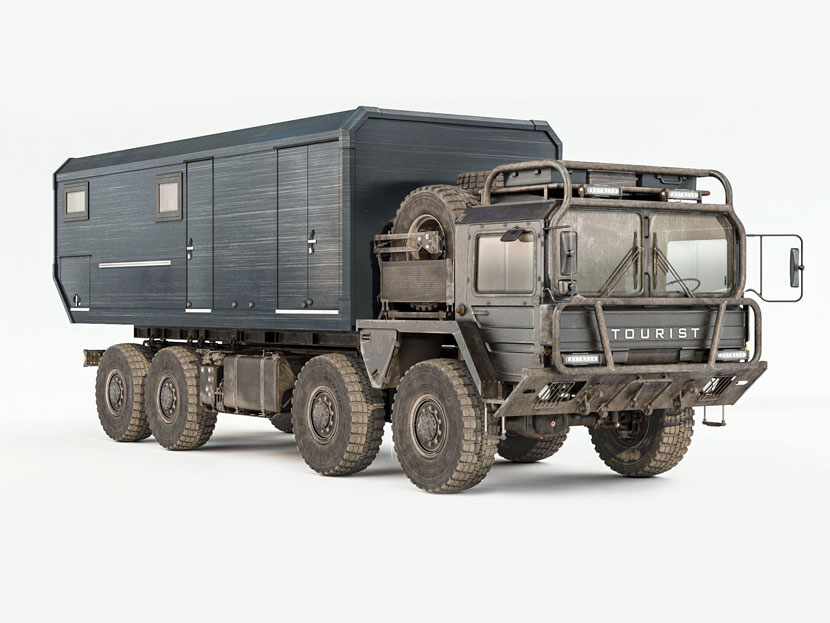Monday, February 1st, 2021 by Julian Karsunky

Oh what a day. What a lovely day…to unveil our February 2021 3D Artist of the Month! Taking the stage is Alexey Ryabov, a self-taught Belarusian CG artist equally adapt at designing luxurious restaurant interiors and military machinery. His faithful recreation of the iconic ‘Doof Wagon’ from the influential 2015 blockbuster ‘Mad Max: Fury Road’ is testament to his spectacular modeling skill and diligent research, and just has to be witnessed.
Continue reading to learn more about Alexey’s professional background and artistic approach in our interview!
 From the movie screen to his PC: Alexey Ryabov recreated the ‘Doof Wagon’ from ‘Mad Max: Fury Road’ in all its postapocalyptic glory.
From the movie screen to his PC: Alexey Ryabov recreated the ‘Doof Wagon’ from ‘Mad Max: Fury Road’ in all its postapocalyptic glory.
Hi Alexey, thanks for joining us! To start things off, please introduce yourself to our readers.
Hi everyone! My name is Alexey Ryabov; I was born in 1993 in the city of Mogilev, Belarus. Since 2010 I have been living and working as a 3D artist in Moscow.
Do you recall when and how you first consciously encountered CGI?
Following the purchase of my first computer in 2007, I took an interest in Adobe Photoshop, though initially I only used it for effects, texts and photo processing. My first real attempt at 3D came in 2009 in the course of this online 3D text tutorial.
Unfortunately, I did not have enough experience back then and couldn't do much of anything. I had not yet discovered my love for 3D at that time.
When and why did you then decide to pursue a professional career as a 3D artist?
I became more serious about 3D around 2013. At first, I saw it exclusively as a hobby, as it allowed me to actively engage with all of my interests: photography, drafting, drawing, engineering and, of course, video games. Then, three years later, I started working professionally, and I have continued to do so to this day.
What training or education do you have?
I am entirely self-taught.
Please tell us about your current job situation!
I am currently working as a 3D artist at Geometry Design, a Moscow-based premium interior design bureau. The key line of our business are restaurants, cafes, country estates, city apartments, boutiques and offices. Our services include everything from developing technical engineering solutions to project management and coordination.
 This sketch features a silhouetted ‘Doof Warrior’ rocking the guitar. Alexey actually fully modelled him in action as well!
This sketch features a silhouetted ‘Doof Warrior’ rocking the guitar. Alexey actually fully modelled him in action as well!
You are also involved in the creation and selling of 3D models. Is this something you are heavily focused on or do you consider it more of a side gig?
It began as a simple side gig, but over time, the sales revenue exceeded my studio salary. Still, all of my models are by-products of my projects, meaning I don't create models specifically for sale; most of the time, I don't even know which models I will sell later. So while it is a fun and profitable undertaking, my main focus has always been on creating cool projects.
How would you describe your profile as a 3D artist?
When I started my career as a 3D artist, I believed that a true 3D artist should be able to do everything: modeling, customizing materials, rendering and post-processing. That is the golden standard that I still try to live up to everyday.
Is there a specific design philosophy or school of thought you adhere to? What inspires you as a 3D artist?
I think so, yes, although it is not limited to my work. In all aspects of my life, I try to act as a role-model for everyone: I do not drink or smoke and avoid other vices as well. I try to be a "real man", to my understanding of this term. My work ethic and everything job-related follows this principle.
What is “3dealization”?
That’s just something I came up with one day that resonated with me, it’s a compound from "3d" and "idealization". It's just a word, for now…
How are you holding up in these trying times? Has the current crisis impeded your work?
Thankfully, not really. I actually found myself having more free time since skipping my daily commute to the office.
 The guitar that started it all: the project evolved from a single prop into its now massive scale.
The guitar that started it all: the project evolved from a single prop into its now massive scale.
Let’s talk about your work in more detail, namely your 3D recreation of the ‘Doof Wagon’, the iconic truck from 2015’s ‘Mad Max: Fury Road’. Can you first describe the circumstances that lead to the creation of this piece?
At the beginning, there was only the guitar, which was my submission to a music-themed 3ddd design competition. I knew I wanted to do something unusual from the start. When I started brainstorming - going through orchestras, concerts and instruments – I eventually landed on the unique aesthetic of Rammstein concerts
When I was done, my colleague Alexander Merchi told me since the guitar was already finished, I now had to do the rest of the truck, too. It was more of an off-hand comment, a joke even, perhaps, but I simply said: “pfft, okay.”
The ‘Doof Wagon’ is based on the MAN KAT1, a military truck which you have also modeled. How much does the movie version have in common with its real-life counterpart?
Oh, there is no significant difference at all. In the film, many additional elements were attached to the truck to blast loud music, but that is pretty much it.
What attracted you to this particular vehicle?
Hmm…I don’t know, the flamethrower, maybe? I mean, you got music, fire and metal – this is ‘Mad Max’!
What were your main goals in doing this project? What parts of the image were especially important to you?
I just wanted to make it cool, something to wow everyone! The most important parts of the image for me were the engine and suspension, which I spent the most time on. Also the wind instruments, located next to the large speakers.
What were some of the challenges you had to overcome?
The main difficulty for me was finding proper reference material. For about half of the time, I was looking for photos and watching various videos.
And, of course, the modeling itself was no easy task. There are about 10,000 objects in total. Moreover, in addition to modeling, it was necessary to observe the scale and location of each object, which was very difficult without access to blueprints or drawings. All in all, I spent about a year and a half working on this project in my spare time.
What software did you use to create this piece? Any plug-ins you found particularly helpful?
I did most of the modeling in 3ds Max, for some parts I used Rhinoceros. I made the textures in 3DCoat, but only masks for some materials; the materials I made in 3ds Max as well. I used V-Ray for rendering and Photoshop for post-processing.
 Alexey’s model of the MAN KAT 8x8 A1 truck, which served as the base model for the ‘Doof Wagon’.
Alexey’s model of the MAN KAT 8x8 A1 truck, which served as the base model for the ‘Doof Wagon’.
You already mentioned the difficulty in finding suitable reference material. Can you elaborate more on your research?
Well, of course I worked closely from still frames from the movie itself as well as behind the scene footage. I found more detailed photos on Prime Portal, a reference site for military vehicles and equipment, which was an invaluable resource. Since the MAN KAT1 truck is the base model for many different military trucks, there were a lot of good photos available.
To get a better understanding of the details, I've looked at individual items such as trailer hitches, tire decals, headlights, and winch and engine parts on eBay and similar sites. Overall, I found 1049 photos in total. Oh, and I also read the repair manuals.
Are you satisfied with the results? What has the feedback been like?
Overall, I am satisfied. Various sites awarded me for this project, somebody even offered a job. More importantly though, I have received many kind and encouraging comments from all sorts of people both online and offline.
What is one thing you have learned from this project that you can share with us?
Working on this project helped me step up my modeling game and increased my overall patience. I also studied 3DCoat and Rhinoceros. In general, I learned a lot of interesting things while looking for references.
 A detailed look at the intricate engine parts, just a few of 10,000 objects Alexey digitally installed in his ‘Doof Wagon’.
A detailed look at the intricate engine parts, just a few of 10,000 objects Alexey digitally installed in his ‘Doof Wagon’.
While technically equally impressive, there is a noticeable contrast in your portfolio subjectwise. Does the gritty heavy machinery serve as a deliberate aesthetic counterbalance to the clean-cut, luxury interiors? Or would that be reading too much into it?
These things complement each other. I just like to experiment and try different things without thinking about it too much. Regardless of the subject, every project completed helps me improve my skills and comes with valuable experience.
Is there a significant difference in how you approach commercial and personal projects?
Mostly in regards to time management, yes. For client work, speed is crucial, but for my personal projects, I can set my own pace. With the exception of interiors, I create all models for my personal projects from scratch. And I spend a lot of time setting up materials, creating textures and post-processing.
Have you used RebusFarm before? If so, please tell us about your overall experience. Is there anything you especially like about our service?
I have not used it yet, as my machines have enough power to suit my needs – I mostly do static images, after all. However, I would certainly rely on your help should I produce an animation or something similarly elaborate.
Alexey, thank you so much for taking the time and all the best in the future!
Keep up with Alexey Ryabov his work here:
HOW TO JOIN OUR MONTHLY CONTEST
You want to be our next featured 3D Artist of the Month and win 250 RenderPoints? Just visit our 3D Artist of the Month competition page and submit your entry. We'll choose the best image and contact the winner.
>> Read more articles on our blog
